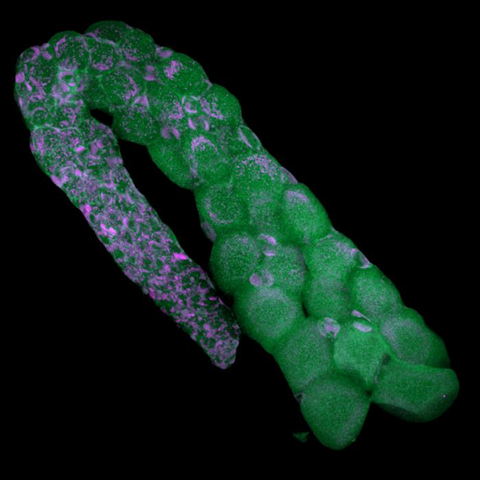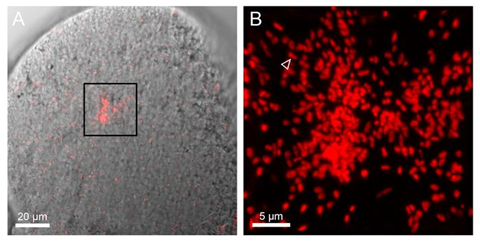Researchers at the Marine Biological Laboratory (MBL) have imaged a heritable form of bacterial symbiosis inside the reproductive system of tiny crustaceans known as ostracods. Led by MBL Whitman Scientist Isa Schön and MBL Research Scientist Scott Chimileski, the study is published this week in Proceedings of the Royal Society B.

Ostracods, sometimes called seed shrimp, are nearly microscopic, aquatic organisms, inhabiting all types of marine and freshwater environments. Using fluorescence microscopy, the team discovered that bacteria from the genus Cardinium live inside the egg cells and tissues of ostracod ovaries.
READ MORE: Human mouth bacteria reproduce through rare form of cell division
READ MORE: New method makes high-throughput process for observing molecules five times faster
In a “true hallmark of endosymbiosis,” said Schön, the bacteria are transmitted from mothers to offspring. These findings suggest that the bacteria manipulate host asexual reproduction.
Endosymbiotic bacteria
While symbiosis with bacteria is an emerging research topic for ostracods, endosymbiotic bacteria have been studied intensely in other arthropods, such as insects.
Mosquitos, Chimileski said, are known to harbor endosymbiotic bacteria from the genus Wolbachia. These bacteria are involved in mosquito reproduction, and can be used to curb the spread of mosquito-borne illnesses. By finding a parallel process in ostracods, scientists can investigate endosymbiosis in an aquatic arthropod that makes up a key part of the food web.

The striking ostracod-bacteria visualizations were the result of a multi-year, multi-lab collaboration between MBL scientists and affiliates.
Schön, a senior scientist at Royal Belgian Institute of Natural Sciences, came to the MBL as a Whitman Fellow in 2022 to develop ostracods as a new research organism. This work helps to counteract the fact that most biological research originates from a handful of model organisms such as fruit flies and mice. “There are endless discoveries yet to be made across the biodiverse animal kingdom on this planet,” said Chimileski.
Imaging challenges
To confirm that symbiotic bacteria are present inside ostracods – and to locate precisely where they may be – the team needed to label the bacteria and use confocal microscopes at the MBL’s Central Microscopy Facility to image the animals at fine, micrometer-size scales. Schön and her colleague, Koen Martens, an evolutionary biologist at Royal Belgian Institute of Natural Sciences, teamed up with Chimileski and Jessica Mark Welch of ADA Forsyth Institute to adapt such methods. Chimileski and Mark Welch are microbiologists with expertise in visualizing the spatial patterns of bacteria in the human mouth and other microbiomes.
“This study establishes non-marine ostracods as the first fully aquatic host system for Cardinium and reinforces their value as models for evolutionary research,” said Schön.
Topics
- ADA Forsyth Institute
- Bacteria
- Cardinium
- endosymbiotic
- Healthy Land
- Isa Schön
- Jessica Mark Welch
- Koen Martens
- Marine Biological Laboratory
- Ocean Sustainability
- ostracods
- ovaries
- Reproductive &Urinary Tract Microbiome
- Research News
- Royal Belgian Institute of Natural Sciences
- Scott Chimileski
- symbiosis
- The Sex Issue
- USA & Canada
- Veterinary Medicine & Zoonoses







No comments yet